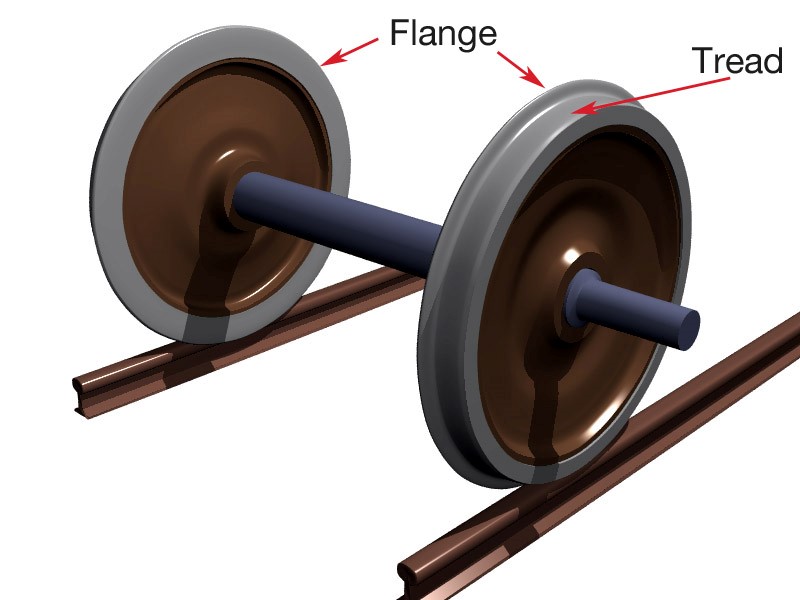Tribology and the air we breathe
Drs. Wilfred T. Tysoe & Nicholas D. Spencer | TLT Cutting Edge December 2016
Study reveals strong speed dependence of particle emissions from wheel-rail contacts.
THE CONTACT BETWEEN TRAIN WHEELS AND RAILS consists of a mixture of rolling contact and sliding. The sliding, and the most wear, take place predominantly on curved rail sections, where contact between the flange and the rail (
see Figure 1) is significant, as opposed to the tread-rail interactions that are more usual on straight tracks. Of the most concern among the wear debris are submicrometer particles, which are believed to be connected with adverse health effects when inhaled over a significant length of time—when commuting or working in an underground railway system, for example (
1).
 Figure 1. Train wheels on rails. (Figure courtesy of Wikipedia.)
Figure 1. Train wheels on rails. (Figure courtesy of Wikipedia.)
While there have been many studies of wheel-rail contact, those reports cover a relatively narrow range of conditions, and few have been concerned with particle emission. Temperature, which is strongly dependent on speed, also can play a major role but has not typically been explored in previous studies. A recent paper in STLE-affiliated journal Tribology Letters by Hailong Liu and colleagues at the Royal Institute of Technology (KTH) in Stockholm, Sweden, and the Swedish Defense Research Agency in Umeå has now set out to correct this situation (
2) by specifically targeting the effect of sliding velocity on wear behavior, contact temperature and particle emission in dry wheel-rail contact and by exploring the wear mechanisms involved.
Experiments were carried out in a pin-on-disk tester using commercial rail and wheel steel materials in pure sliding contact. The tests were performed over 20 minutes in a sealed system at speeds corresponding to rail-tread contact (0.1 m/s), rail-flange contact (0.4 m/s) and extreme conditions such as those encountered in braking in sharp curves (1.2 and 3.4 m/s). The normal load was 5 N, corresponding to 800 MPa contact pressure. Filtered air was flowed over the contact and the entrained particles removed for sampling and size measurement by electrical mobility and optical detection. Particles also were collected electrostatically for subsequent chemical analysis by energy-dispersive x-ray microanalysis (EDS).
For the lowest sliding speed, a low particle count (<3 x 10
2/liter) was detected, while for high speeds considerably more particles were detected. For the highest speed—at which (considerably underestimated) temperatures of around 60 C were recorded—particle counts of around 10
5/liter were noted throughout most of the test. For both the 1.2 m/s and 3.4 m/s tests, spikes in the particle count in the millions/liter were observed. Greater than 90% of all particles generated during the tests were below 1 µm (i.e., potentially harmful) and a larger proportion of fine particles (<400 nm) was noted for the higher speeds.
Interestingly the highest wear rate was found at lower speeds since the wear debris contained a significant fraction of large particles. SEM images of pins from these tests also showed signs of heavy scoring and delamination, suggesting a combination of abrasive and adhesive wear, while pins from the higher-speed tests were much smoother. The observation that the particles released were smaller and that EDS revealed them to consist largely of iron oxides suggests that at high speeds, oxidative wear was the dominant mechanism leading to particle formation.
The propensity for the high-speed tests to produce vast numbers of potentially hazardous particles suggests that braking in narrow curves in a confined environment (e.g., subway) could be particularly problematic from a health point of view. This study has now raised awareness of the issue and further studies are clearly warranted.
REFERENCES
1.
Knibbs, L.D., Cole-Hunter, T. and Morawska, L. (2011), “A review of commuter exposure to ultrafine particles and its health effects,”
Atmos. Environ.,
45 (16), pp. 2611-2622.
2.
Liu, H., Cha, Y., Olofsson, U., Jonsson, L.T.I. and Jönsson, P.G. (2016), “Effect of the sliding velocity on the size and amount of airborne wear particles generated from dry sliding wheel-rail contacts,”
Trib. Lett. 63 (3), p. 23.
 Eddy Tysoe is a distinguished professor of physical chemistry at the University of Wisconsin-Milwaukee. You can reach him at wtt@uwm.edu
Eddy Tysoe is a distinguished professor of physical chemistry at the University of Wisconsin-Milwaukee. You can reach him at wtt@uwm.edu.
Nic Spencer is professor of surface science and technology at the ETH Zurich, Switzerland. You can reach him at nspencer@ethz.ch.
Both serve as editors-in-chief of STLE-affiliated Tribology Letters journal.